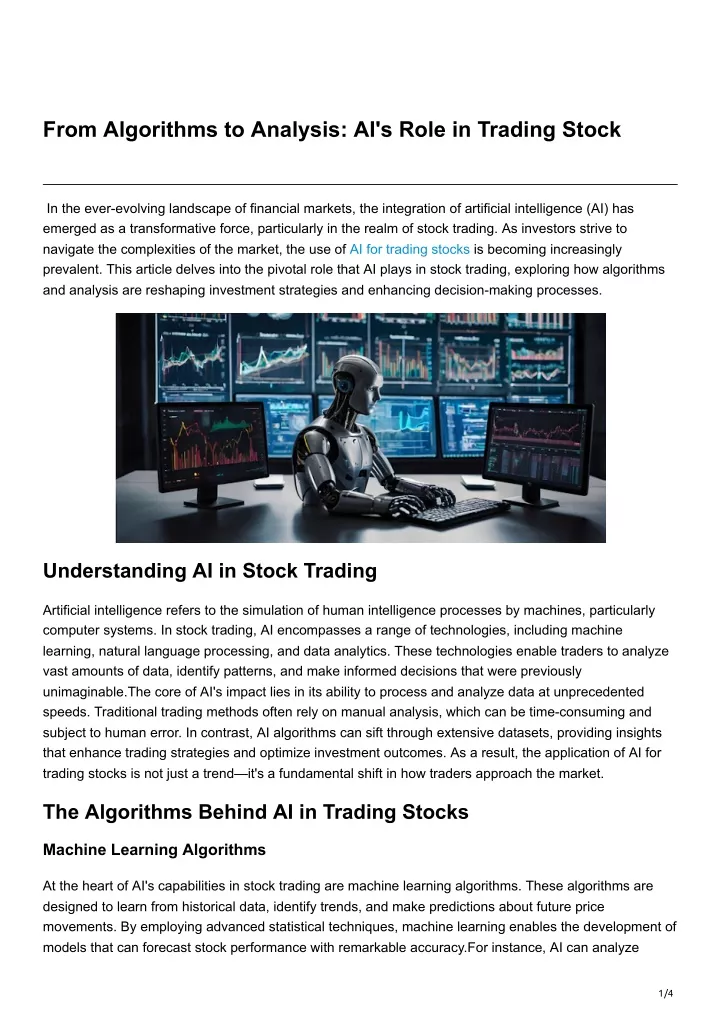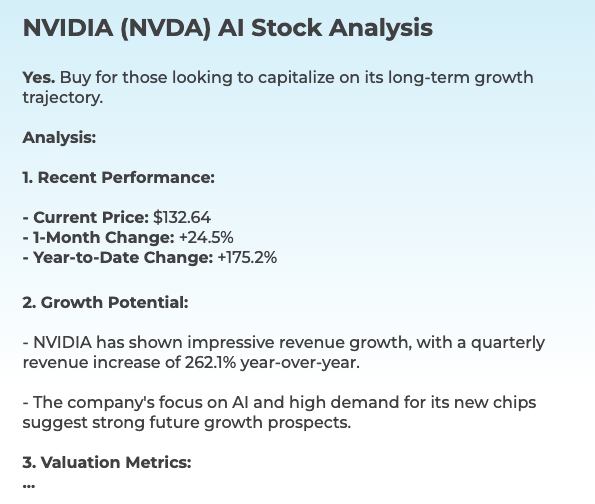AI software for predicting or analyzing stocks offers a number of customization options, which allow users to modify their platform to meet their own trading goals in terms of risk-taking, as well as market conditions. Platforms that offer a variety of customizations can enhance your trading. Here are the top ten tips for evaluating the ability to customize your strategy on these platforms:
1. Evaluate Pre-Built Strategy Templates
Many templates - Look for already-built strategies that can be adapted to various trading styles.
You are able to easily alter the templates to adapt them to meet your requirements.
Performance history: Find out whether you have access to historical information about the performance of pre-built strategies.
2. Review Custom Strategy Creation
Drag-and-drop tools Search for platforms that offer intuitive drag-and-drop interfaces that allow you to design customized strategies.
Find out about coding options. For advanced users it is possible to determine if the platform offers custom coding.
Flexibility: Make sure your platform allows you to define your entry/exit parameters as well as risk management metrics as well as other crucial elements of your plan.
3. Check for Backtesting Capabilities
Historical data: Verify if the platform provides sufficient historical data to backtest your strategies.
Customizable settings: Be sure that you are able to change parameters during backtesting.
Performance metrics: Ensure that the platform provides detailed metrics of performance (e.g. Win rate, Sharpe Ratio, Drawdown) when testing strategies.
4. Evaluate Real-Time Strategy Testing
Paper trading: Check if the platform supports paper trading and simulation modes for testing strategies in real-time without risking your capital.
Live testing is a great method of determining whether your strategy is able to be tested in the market in tiny amounts.
Real-time adjustments: Check to see if your strategy can be adapted in real-time to the market conditions.
5. Examine the degree of integration using technological indicators
Libraries of indicators: Ensure that the platform includes a complete collection of tools for technical use (e.g. MACD, RSI and moving averages).
Custom indicators: Ensure that you have the ability to import or develop custom indicators for your strategies.
Check if you can combine several indicators to make more complicated strategies.
6. Check for Risk Management Tools
Stop-loss/take-profit: Ensure the platform allows you to set stop-loss and take-profit levels within your strategies.
Size of your position. Check whether you have rules in place for the best way to handle your risk (e.g. set amount per portfolio, percentage).
Risk-reward ratio: Determine whether the platform can set risk-reward ratios on individual strategies or trades.
7. Evaluate Multi-Asset Strategy Support
Asset classes: Ensure that your platform is able to support multiple asset classes, including ETFs, stocks and options.
Cross-asset strategies : You can develop strategies that incorporate multiple asset categories (e.g. pairs trading hedges, pair trading).
Market coverage - Make sure that the platform is covered by markets you are interested (e.g. US and international markets and copyright, etc.).
8. Assess Automation & Execution
Automated trading: Ensure the platform is able to automate the execution of strategies based upon defined rules.
Types of orders: Check to see if the platform allows for different order types (e.g. limit and market) when you are executing a plan.
Latency: Verify whether the platform is able to execute trades with minimal latency, particularly when using high-frequency strategies.
9. Check for Strategy Optimizing Tools
Parameter optimization. Make sure your platform allows you to improve the parameters of your strategy (e.g. Grid search Genetic algorithms).
Machine learning integration: Find out whether the platform is integrated with machine learning to improve and enhance strategies.
Analysis of scenarios: Ensure that the platform is able to test strategies in different market conditions (e.g. volatile bull, volatile, or bear).
Check out the Community Feedback and User Reviews
Feedback from users is essential to assess the performance of a platform.
Community forums: Find out if the platform has an active community of users who are able to discuss and discuss customized strategies.
Support resources: Make sure that the platform has tutorials, documentation, as well as webinars that will help users create and implementing strategies.
Bonus Tips:
Free trial period: You can try out the customizable options of the platform using a the demo or trial.
Scalability: Make sure the platform you choose to use can deal with complex strategies that evolve as you trade.
Support for customers: Find out whether the platform offers support for issues related to strategy and queries.
By following these tips you will be able to effectively evaluate the strategy customization capabilities of AI platforms for analyzing and predicting stocks, ensuring you choose one that matches your trading goals and allows you to develop and improve your strategies effectively. A platform that is robustly customizable capabilities can allow you to adapt to changing market conditions and improve the performance of your trading. See the top rated see page for website tips including AI stock picker, AI stock, ai trading, AI stock market, market ai, ai investment app, market ai, ai trading, best AI stock, ai investing platform and more.

Top 10 Tips For Evaluating Regulatory Compliance With Ai Trading Platforms That Predict Stocks Or Analyze Their Performance.
Compliance with regulatory requirements is an essential factor when looking at AI trading platforms for stock prediction or analysis. Compliance ensures that the operation of a platform is within legal frameworks. Data of users is secured and financial regulations are adhered to and reduces the risk of legal issues. Here are top 10 tips on how to evaluate the level of compliance these platforms have.
1. Verify the Licensing & Registration
Regulators: Make sure your platform is registered and regulated by the appropriate financial regulatory authorities (e.g., SEC in the U.S., FCA in the UK, ASIC in Australia).
Broker partnership: If the platform integrates with brokers, ensure that brokers are legally licensed and regulated.
Public records: Check the official website of the regulator for the platform's registration status and any previous violations.
2. Compliance with Data Privacy Evaluation
GDPR - If your site is located in the EU or serves users from the EU make sure that it complies with GDPR.
CCPA: California Consumer Privacy Act compliance is required for users.
Data handling policy: Make sure that you go through the platform's privacy policies to understand the way in which user data is gathered and stored.
3. Evaluation of Anti-Money-Laundering Measures
AML Policies The platform should be equipped with robust AML (Anti-Money Laundering) policies to detect money laundering and stop it.
KYC Procedures: Verify whether there are procedures on the platform for confirming users' identities.
Monitoring transactions You can find out if the platform monitors transactions for suspicious activities and notifies the authorities.
4. Verify compliance to Trading Regulations
Market manipulation: Ensure the platform has measures to prevent market manipulation, like spoofing or wash trading.
Order types. Examine whether your platform is in compliance with the rules for orders.
Best execution : Make sure that the platform employs top execution techniques to complete trades at a competitive cost.
5. Examine Cybersecurity Compliance
Data encryption: Ensure that the platform uses encryption to safeguard data either in transit or when it is at in rest.
Incident response. Verify that there is a clearly defined incident response strategy on the platform for cyberattacks and data breaches.
Certifications: Determine if the platform holds cybersecurity certifications (e.g., ISO 27001, SOC 2).
6. Examine Transparency and Disclosure
Fee disclosure: Ensure that the platform clearly outlines the total amount of fees, which includes hidden or additional charges.
Risk disclosure: Check if the platform has explicit risks disclosures. Particularly, for high-risk or leveraged trading strategies.
Performance reporting: Ensure that the platform produces transparent and exact performance information for its AI model.
7. Check for Compliance With International Regulations
Trans-border trade. If you intend to conduct international trade, make sure that your platform adheres to all regulations applicable to it.
Tax reporting: Determine if a platform has tools or reports for users to comply with tax regulations.
Compliance with international sanctions: Ensure that your platform is in strict compliance with these and doesn't allow trading with prohibited entities or countries.
8. Examining Audit trail and Record-Keeping
Records of transactions: The platform needs to maintain detailed records on the transactions that are used for regulatory and auditor reasons.
Logs of user activity: Check if the platform logs users' activities, including transactions, logins, and changes to the account settings.
Audit-readiness: Find out if the platform will be able to produce all required documentation and logs for a possible regulatory audit.
9. Check for compliance with AI-Specific Regulations
Algorithmic rules of trading: If the platform supports algorithmic trading, it should be in compliance with European regulations, such as MiFID II and U.S. Reg SCI.
Bias and Fairness: Verify that the platform monitors biases and minimizes them within its AI models in order to guarantee fair trade.
Explainability. Some regulations may need the platform to explain AI-driven prediction and decisions.
10. Review feedback from users and review the regulatory history
Feedback from users: Read reviews from users to determine the platform’s reputation for regulatory conformity.
Historical Record: Search for any past violations of regulations, fines or penalties.
Third-party auditors: Find out if the platform is regularly audited by a third party to make sure it is adhering to rules and regulations.
Bonus Tips
Legal consultation: Talk to an expert in the field to check if your platform is in compliance with regulations.
Trial period: Take advantage of an unpaid trial or demo to assess the platform's compliance features and documentation.
Support for customers - Ensure that the platform has the capacity to assist with any compliance related issues or concerns.
These tips will help you to assess the regulatory compliance for AI platforms for analyzing and predicting stocks. You will be able choose a system that is in compliance with legal frameworks while protecting your rights. Compliance not only minimizes legal risks, but also increases confidence and trust in the services of the platform. Take a look at the best ai options trading info for blog info including AI stock prediction, chart analysis ai, stock predictor, ai software stocks, ai investment tools, ai options trading, best AI stocks to buy now, best ai penny stocks, stocks ai, ai share trading and more.
